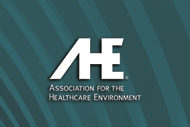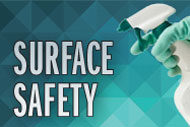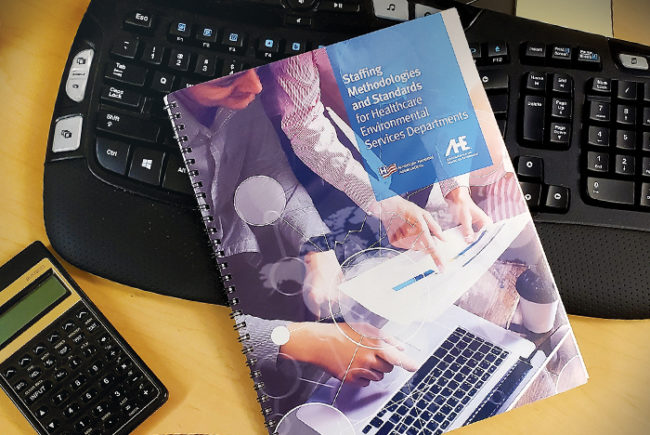
This initiative is funded by an unrestricted educational grant from Clorox Healthcare™.
Hospitals must optimize surface cleaning and disinfection practices. It’s as much an imperative for improving patient safety and quality as it is an economic mandate, with the declining reimbursement levels hospitals are seeing from Medicare and Medicaid.
With this in mind, experts advise environmental services (ES) teams and staff infection prevention and epidemiology leaders to focus on best practices in training, educating, monitoring and measuring surface cleaning and disinfection performance. This requires ES teams to be educated thoroughly about the cleaning products and disinfectants they use, their specified dwell times, use sites and product labeling.
William A. Rutala, Ph.D., director of the hospital epidemiology and occupational health and safety program at the University of North Carolina hospitals, notes that the scientific literature is clear on the importance of superior surface cleaning and disinfection practices.
“There is excellent evidence in the scientific literature that environmental contamination plays an important role in the transmission of several key health care-associated pathogens, including methicillin-resistant Staphylococcus aureus (MRSA), vancomycinresistant Enterococcus (VRE), Acinetobacter, Norovirus and Clostridium difficile,” Rutala says. “All these pathogens have been demonstrated to persist in the environment for hours to days — and, in some cases, months. They frequently contaminate the rooms of colonized or infected patients, transiently colonize the hands of caregivers, and can be transmitted by health care personnel and cause outbreaks in which the environment was deemed to play a role.”
A study published in the February issue of the American Journal of Infection Control found that Norovirus alone was responsible for 18.2 percent of all infection outbreaks and 65 percent of ward closures in U.S. hospitals during 2008 and 2009.
Assessing the greatest opportunities for improving surface cleaning and disinfection practices, Rutala says several investigators have achieved significant improvements in cleaning practices by taking a multifaceted approach. This includes improving education, using cleaning checklists, monitoring the thoroughness of cleaning with the use of adenosine triphosphate (ATP) assays or fluorescent dyes, and giving feedback to ES staff.
Children’s Hospital of Philadelphia has taken this type of approach in its successful efforts to reduce health care-associated infections (HAIs) and continuously build ES team competencies, achieving sustained reductions in viral infection rates. Tina Cermignano, CHESP, the hospital’s business and department operations manager, says new ES staff undergo a rigorous three-week educational program covering topics like the science of cleaning, chemical review, potentially infectious microorganisms and more. The hospital also has an ATP surface cleaning monitoring program, which provides workers with feedback on their cleaning thoroughness on high-touch areas. Through its quality control program, Cermignano and her colleagues are able to determine when minimum thresholds are not attained and offer staff retraining as needed.
The ES and infection prevention teams at Hunterdon Medical Center, Flemington, N.J., have taken similar steps in developing their ES program, which contributed to a 46 percent reduction in MRSA and a 23 percent reduction in VRE transmission in 2011, notes Kathy Roye-Horn, R.N., CIC, director of infection prevention. Among the surface cleaning and disinfection strategies Roye-Horn and Marita Nash, CHESP, director of ES and linen, deploy include a detailed cleaning sequence for staff to follow, implementing ATP and establishing minimum cleaning times for occupied rooms and terminal cleaning of rooms.
Another key to their success, Roye-Horn says, is a growing commitment from the professional and ancillary staff to clean items that go rapidly from patient to patient, such as stethoscopes, wheelchairs and stretchers. In addition, a touchable cleaning surface checklist of 30-plus items is given to all ES staff. “We guide employees every step of the way, including when to change their microfiber cleaning cloths,” Nash says.
As many experts recommend, Nash and her team conduct post-discharge cleaning inspections, periodically monitoring with ATP six different high-touch areas in patient rooms and changing the surfaces tested periodically so staff won’t know which areas will be inspected.
Karen Martin, R.N., director of infection prevention and environmental services at Advocate Christ Medical Center and Hope Children’s Hospital, Oak Lawn, Ill., says her facilities have made steady and, in some cases, dramatic progress by investing in education, evidence-based cleaning practices and tools, and consistently providing employee feedback.
“Currently, we’re at about 85 percent for hitting all 17 high-touch cleaning areas identified by the Centers for Disease Control and Prevention when we monitor rooms,” Martin says. Her successful educational efforts include showing ES staff images of patients with MRSA, C. diff and other serious infections to drive home the significance of surface cleaning.
Ruth Carrico, R.N., Ph.D., associate professor, Health Promotion and Behavioral Sciences Department’s Center for Health Hazards Prepared ness, University of Louisville (Ky.), encourages using human factors engineering approaches to product usage.
“Focus on how to make it easy for ES workers to do the right things and difficult for them to do the wrong things. For example, if you don’t want them to be mixing products, provide them with products delivered in ready-to-use form or be sure they’re only able to be used after they’re mixed properly,” Carrico says.
She also stresses that surface cleaning should become everyone’s responsibility in the hospital and that nurses and others be given the appropriate cleaning and disinfectant wipes or other tools to do their part.
Finally, it’s essential to provide education and training any time a new surface cleaning or disinfectant product is introduced into the environment. With the recent introduction of products containing “improved, accelerated or enhanced” hydrogen peroxide, for example, ES leaders and staff need to understand the fundamentals of their appropriateness for cleaning and disinfecting specific types of hospital surfaces.
“Improved hydrogen peroxide (IHP) contains low levels of anionic and nonionic surfactants which act with hydrogen peroxide to produce microbiocidal activity. This combination of ingredients speeds the antimicrobial activity of the hydrogen peroxide, improves cleaning efficiency and enhances its material compa tibility. IHP is considered safe for humans and benign for the environment,” Rutala explains. “Lower concentrations, 0.5 and 1.4 percent, are designed for the low- and intermediate-level disinfection of noncritical environmental surfaces and patient care objects while the higher concentrations, greater than 2 percent, can be used as high-level disinfectants for semicritical medical devices such as endoscopes.”
Educating the ES team to follow labeling instructions for all products used, site uses, organism kill times and other factors is critical to optimizing surface cleaning and disinfection practices.
Resources
- Centers for Disease Control and Prevention toolkit on Evaluating Environmental Cleaning
- Centers for Disease Control and Prevention, Guideline for Disinfection and Sterilization in Healthcare Facilities
- Association for the Healthcare Environment
- Association for Professionals in Infection Control and Epidemiology: Clean Spaces, Healthy Patients





